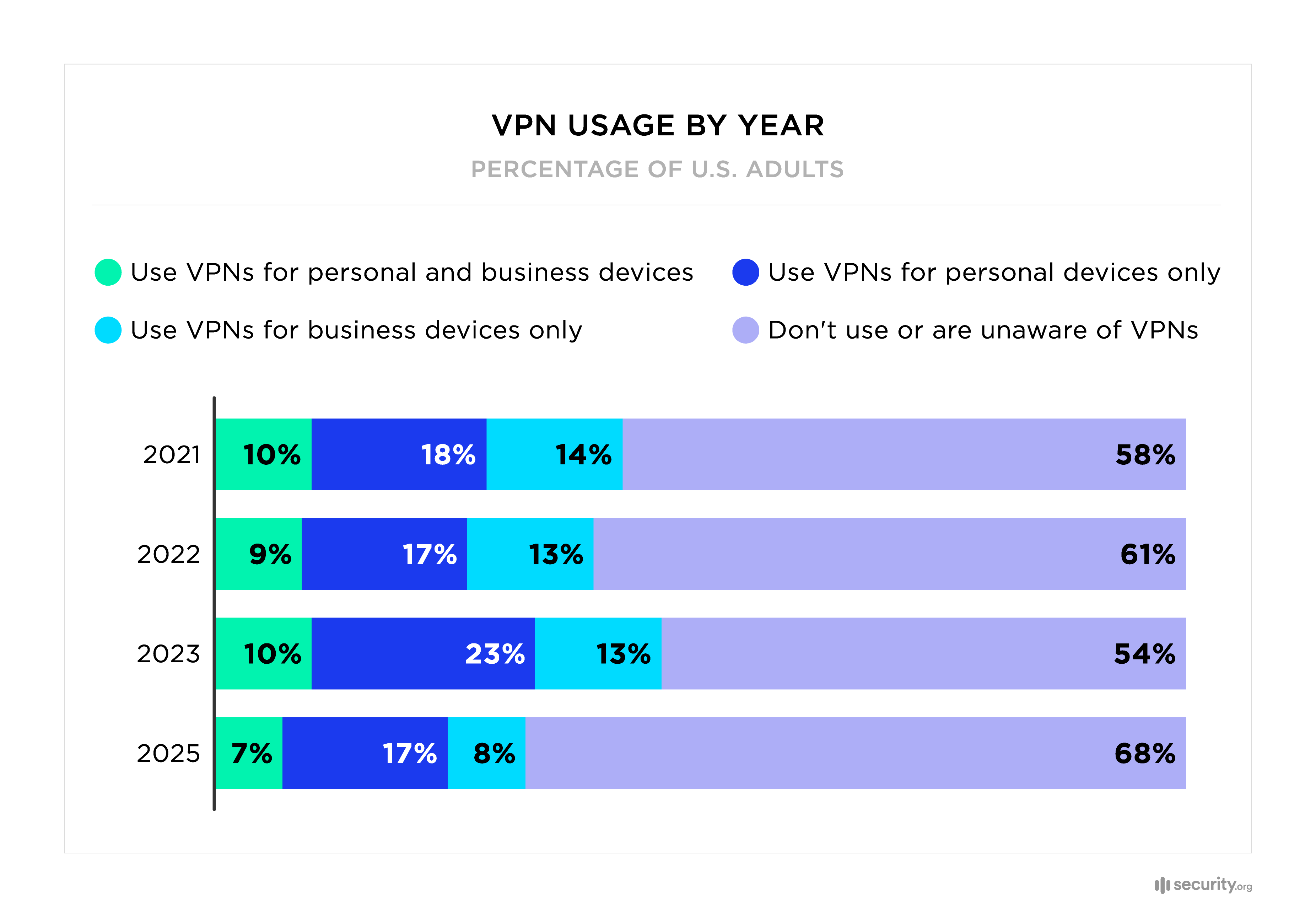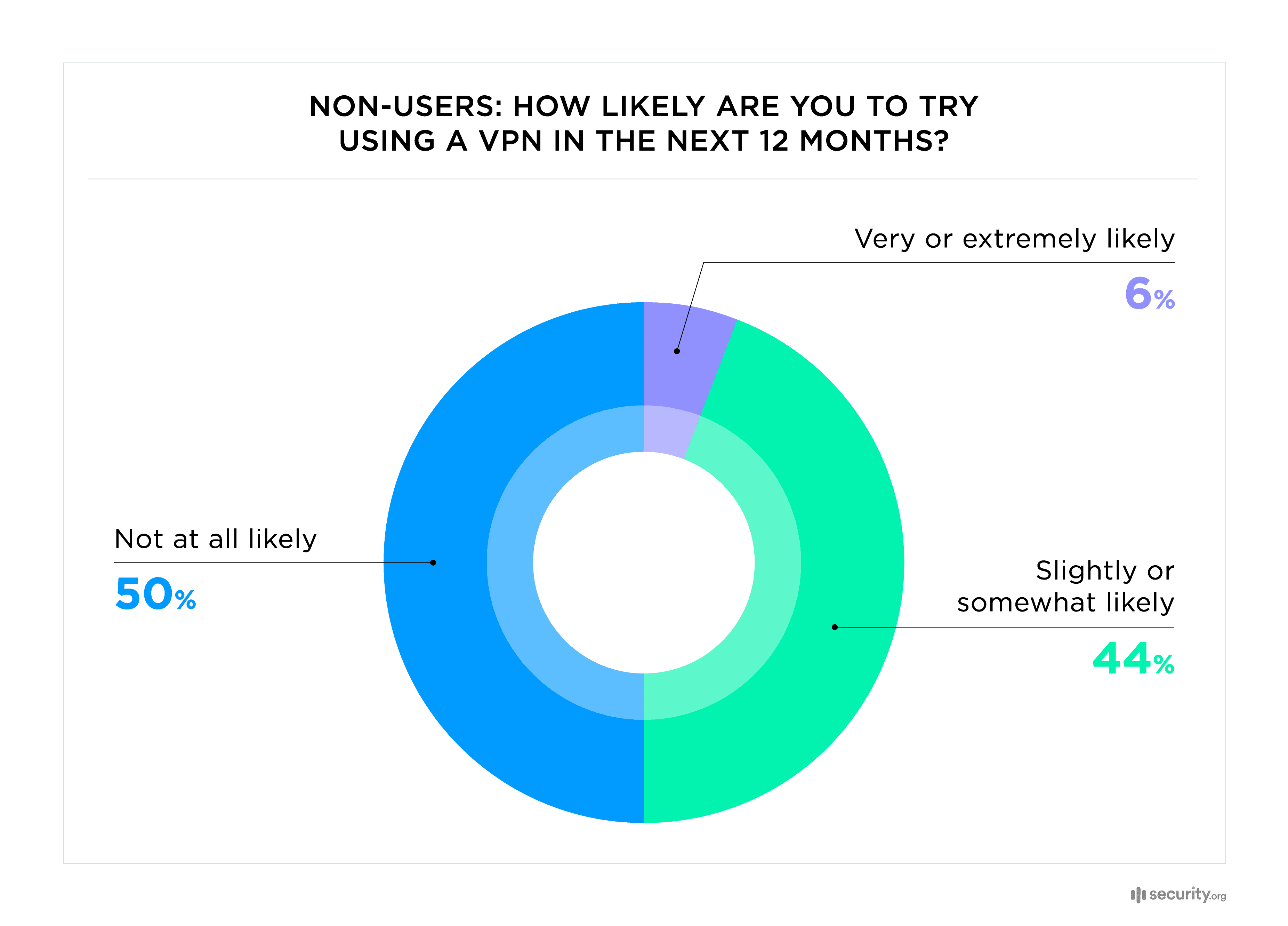VPN Use in 2025: Trends, Statistics, and Consumer Sentiment
Today, about 75 million Americans use VPNs to improve online privacy and security.
Key findings:
- VPN usage declined since 2023: 32% of Americans now use VPNs, down from 46%
- Business VPN use continues shrinking: Only 8% of adults use VPNs solely for work, compared to 13% in 2023
- 37% of users turned to VPNs to reduce tracking by search engines or social media platforms, and nearly 1 in 4 used VPNs to access streaming content not available in the U.S.
- The most popular VPN brands in the U.S. are NordVPN, Proton VPN and ExpressVPN
- Despite security risks, 28% of users rely on free VPN options
- VPN usage was most prevalent among the 18-29 age group, with almost 40% reporting regular use
In an age of endless data breaches and rising cybercrime, you’d think more Americans would turn to virtual private networks (VPNs) to protect their online privacy. Our latest annual study, however, reveals a surprising twist: VPN usage has dropped, from 46 percent in 2024 to 32 percent this year.
So what gives?
Each year, we survey over 1,000 adults in the U.S. to understand how people use VPNs and what they think about them. This year’s data tell a story of a changing digital landscape. While privacy concerns intensify, workplace VPN requirements are “out to lunch,” and many Americans remain skeptical about whether they actually need these tools.
What’s driving this change? And why do privacy-conscious Americans continue embracing VPN technology while others abandon it entirely? Our research uncovers the forces reshaping how Americans think about digital privacy and what it means for their online security.
Our Methodology
Data in this report comes from a nationally representative online survey of 1,009 U.S. adults we conducted in June 2025. It also includes year-over-year trends from our research dating back to 2021. The online platform used to gather data for this study doesn’t allow users to access it using a VPN, which may have resulted in underreporting the number of people using VPNs.
VPN Usage in 2025: Personal vs. Business Use
Three out of four Americans today recognize what VPNs are, but far fewer are actually using them. According to our 2025 survey of 1,009 American adults, just 32 percent of respondents currently use a VPN—a significant drop from 46 percent in 2023 and down from 39 percent in 2022.

While overall usage dropped, personal privacy motivations remain rock-solid. The 17 percent of people who use VPNs exclusively for personal reasons represent millions of Americans who’ve consciously decided to protect their digital lives, regardless of what their employers require. Business VPN use saw the sharpest decline, falling to just eight percent of adults.
Common reasons for using VPNs
Among users, by year
| Why do you use a VPN? | 2021 | 2022 | 2023 | 2025 |
|---|---|---|---|---|
| For general privacy | 54% | 50% | 63% | 60% |
| For general security | 55% | 55% | 54% | 57% |
| To use public Wi-Fi more securely | 34% | 24% | 36% | 37% |
| To prevent tracking by search engines or social media (e.g. Google, Facebook) | 18% | 17% | 39% | 32% |
| Job requirement | 38% | 34% | 39% | 25% |
| For greater security when online shopping | 24% | 20% | 25% | 25% |
| To access media content not available in your country | 19% | 22% | 28% | 23% |
| To hide your internet activity from your ISP | 23% | 23% | 35% | 21% |
| Torrenting | 13% | 12% | 21% | 13% |
| For work in activism/journalism/whistle-blowing/research | 3% | 5% | 4% | 6% |
Note: Multiple responses allowed
VPN User Demographics
Age-driven adoption patterns
The 18-29 demographic leads the charge, with nearly 40 percent using VPNs regularly. Usage steadily declines with age, dropping to just under 30 percent among those 60 and older. This isn’t just about tech-savviness—younger users have grown up understanding that their digital footprints follow them everywhere.
Gender usage gap
Men are more likely to use VPNs (39 percent) compared to women (30 percent). This difference may relate to technical familiarity and comfort with privacy tools.
Technical knowledge matters
Users who describe themselves as “very” or “extremely” familiar with VPNs don’t just use them more—they’re also more likely to layer additional privacy tools like Tor browsers into their digital security stack.
International streaming content access remains a major use case
Beyond privacy and security concerns, a significant portion of VPN users (23 percent) leverage these tools to access international streaming content unavailable in the United States. This behavior reflects the fragmented nature of global content licensing, where movies and shows may be available on Netflix in one country but not another, or where certain platforms operate exclusively in specific regions. The practice has become so common that streaming services have had to get better and better at detecting VPNs with increasingly powerful tech.
Privacy and security drive personal VPN adoption
When we asked VPN users why they rely on these tools, their motivations clearly reflected digital-age concerns. Major data breaches continue exposing millions of personal records, while new state laws restricting access to certain websites have pushed some users toward VPNs for basic internet access. Meanwhile, the ongoing battle between privacy advocates and big tech over data collection has made “avoiding tracking” a mainstream concern rather than a niche worry
Why is Business VPN Use Decreasing?
The decline in workplace VPN usage reflects a fundamental shift in how companies approach remote access security. Traditional VPNs, once the gold standard for connecting remote workers, are increasingly viewed as a potential risk rather than a trusted solution.
Recent industry research shows that 92 percent of organizations worry that VPN vulnerabilities directly lead to ransomware attacks. These concerns aren’t just theory—VPNs and firewalls now account for 58 percent of ransomware incidents, making them the primary attack vector cybercriminals exploit.
The response has been swift and decisive. According to enterprise security surveys, 65 percent of organizations plan to replace their VPN services within the year, while 81 percent are transitioning to zero-trust security frameworks by 2026. This shift explains why personal VPN use remains steady while business use continues to decline.
The Top VPN Brands in 2025
Despite hundreds of VPN options flooding the market, American consumers consistently gravitate toward a select group of trusted providers. Our survey reveals that NordVPN was the most-used VPN, with 17 percent of users. It has held this position for two years running through consistent innovation and unwavering focus on privacy protection.
Top VPN brands
Among users, by year
| What brand of VPN do you use? | 2023 | 2025 |
|---|---|---|
| NordVPN | 27% | 17% |
| Proton VPN | 13% | 9% |
| ExpressVPN | 8% | 9% |
| Norton Secure VPN | 6% | 8% |
| Private Internet Access | 7% | 6% |
| Windscribe | 3% | 6% |
| Google One VPN | 9% | 5% |
| Surfshark | 5% | 4% |
| Brave VPN | 7% | 3% |
| Mozilla VPN | 5% | 2% |
| CyberGhost | 4% | 2% |
| Mullvad VPN | 4% | 2% |
| IPVanish | 3% | 2% |
| Atlas VPN | 3% | 0% |
| Other VPNs | 21% | 11% |
The most popular VPNs in 2025 (by user share) are:
This ranking reflects more than just marketing reach—it demonstrates how users prioritize different aspects of VPN service based on their individual needs and technical comfort levels.
Two Distinct VPN User Categories Emerge
Our data reveals VPN users fall into two primary categories—privacy-first and convenience-focused—each with distinct priorities. Privacy-first users choose services like NordVPN and Proton VPN specifically for their strong encryption standards, verified no-logging policies, and transparent security practices. These users often research technical specifications and prioritize features like advanced protocols and independent security audits.
Convenience-focused users gravitate toward bundled services like Google One VPN or trusted brands like Norton. These users value simplicity, familiar interfaces, and integrated security suites that handle multiple digital safety needs in one package.
Innovation Keeps Market Leaders Ahead
The most successful VPN providers maintain their positions through continuous feature development that addresses evolving user needs:
- Multi-device flexibility: Leading services support 10+ simultaneous connections, accommodating households with multiple smartphones, laptops, tablets, and smart devices
- Global infrastructure: Top providers operate thousands of servers globally, ensuring reliable connections and content access worldwide
- Speed optimization: Advanced protocols like WireGuard and proprietary acceleration technologies minimize the performance impact users traditionally associated with VPNs
- User-friendly design: Simplified apps make VPN protection accessible to non-technical users while offering advanced settings for power users
- Integrated security ecosystems: Bundled features like antivirus protection, ad blocking, and dark web monitoring appeal to users seeking comprehensive digital protection
The trend toward integrated security suites reflects broader changes in how Americans approach digital protection. Rather than managing separate tools for different threats, many users prefer unified platforms that address multiple security concerns through a single interface and subscription.
Free VPNs: Still Common, But Users Report Growing Issues
Free VPNs remain widespread among American users, with 28 percent of VPN users relying on them, though this represents a significant decline from previous years. Among those who pay for VPN services, the median monthly cost is $10, with most plans ranging from $2 to $15 per month, depending on features and subscription length. This shift toward paid services reflects growing awareness of the substantial risks associated with free VPN offerings.
For many Americans, the appeal of free VPNs comes down to simple economics and convenience. Free services offer an easy, no-commitment entry point for users who want basic privacy protection or need to bypass a one-time content restriction. While free VPNs appear cost-effective, they come with significant trade-offs that often undermine their core purpose.

Many users described switching to paid services after repeated frustrations with free options, suggesting that the “free” approach often becomes more expensive in terms of time, security risks, and lost productivity.
Barriers to VPN Adoption
Despite growing cybersecurity threats and privacy concerns, most Americans still don’t use VPNs. Our 2025 data shows that 68 percent of respondents either don’t use VPNs or remain unaware of them—a sharp increase from 54 percent in 2024. Understanding these barriers reveals important insights about public perceptions of digital privacy tools.
Non-users cited a number of barriers to VPN use that reflect both practical concerns and knowledge gaps.
| Why don’t you use a VPN? | Percentage of non-users |
|---|---|
| I don’t need one | 30% |
| I don’t see the benefit | 18% |
| I don’t know enough about them | 15% |
| Too expensive | 14% |
| Sites block them | 6% |
| Too much trouble to set up | 5% |
| I don’t trust their privacy | 4% |
| I don’t trust their security | 4% |
The Path Forward: Education and Simplified Solutions
Research data also highlights a clear connection between user awareness and adoption. Users familiar with VPN technology were significantly more likely to use these services and understand their limitations. This suggests that targeted education focusing on relatable use cases—like securing public Wi-Fi or preventing location tracking—could help increase adoption rates.

2025 Outlook: Privacy, Convenience, and a Maturing Market
VPNs may not be for everyone, but for millions of Americans, they remain an essential part of their digital safety toolkit. Nearly two-thirds of VPN users highlight privacy protection and enhanced general online security as their top concerns in 2025. As user needs evolve, expect to see VPNs become even more integrated, flexible, and user-friendly—especially as new threats and regulations keep the conversation about online security front and center.
Whether you’re a privacy-conscious shopper, a frequent traveler, or just someone who wants a little more control over your digital life, VPNs still offer powerful protection in a rapidly changing world. The question for 2025 isn’t just “Should I use a VPN?”—it’s “What do I want my VPN to do for me?”
Frequently Asked Questions: VPN Usage
Q: What percentage of Americans used a VPN in 2025?
A: 32% of U.S. adults used a VPN in 2025, down from 46% in 2024.
Q: What is the most popular VPN brand in 2025?
A: NordVPN, used by 17% of VPN users.
Q: What are common reasons people use VPNs?
A: The most common reasons people use VPNs are to increase general web privacy and security, to improve safety on public wifi networks, to prevent tracking online, and to increase security during online shopping transactions.
